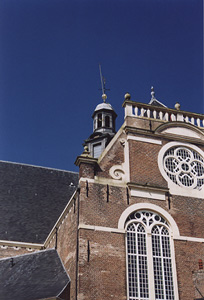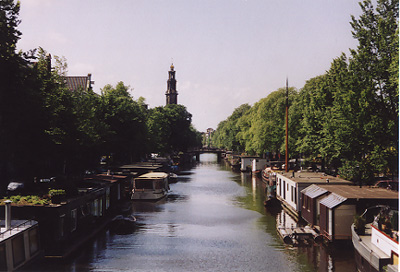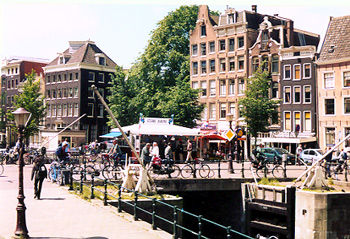 The Jordaan district
is in the north-northwest section of Amsterdam, a bit off the tourist
path (thankfully!). It's a very quiet residential area with tons of great
restaurants (Thai, Indonesian, Italian, Spanish) and neighborhood bars
overflowing with Brand, Leeuw, Palm, Amstel, Dommelsch Pils, and more!
The Jordaan district
is in the north-northwest section of Amsterdam, a bit off the tourist
path (thankfully!). It's a very quiet residential area with tons of great
restaurants (Thai, Indonesian, Italian, Spanish) and neighborhood bars
overflowing with Brand, Leeuw, Palm, Amstel, Dommelsch Pils, and more!
It seems that each area of Amsterdam is marked with a central church. To the right is Noorderkerk, which was at the end of the street where we lived. Its plaza is the site of large weekend markets and lots of activity.
 To
the left is Westerkerk, looking down the Prinsengracht canal. Westerkerk
is the church next to the Ann Frank house, and is the tallest church in
Amsterdam at 275 feet.
To
the left is Westerkerk, looking down the Prinsengracht canal. Westerkerk
is the church next to the Ann Frank house, and is the tallest church in
Amsterdam at 275 feet.
Notice how the canal is lined with houseboats. Not seen in the picture is the large number of coots that lived in the canals. They were not at all timid about humans, and nested on anything resembling a raft (sometimes with dire consequences when the raft was too tall for the babies to get back on once they fell out of the nest, as we observed with dismay).
 The oldest canal is
Singel. The three other main canals are Herengracht, Kaizersgracht, and
Prinsengracht (think alphabetically: gentlemen, kaizer, prince). They
are frequently crossed with raisable suspension bridges, such as the one
to the right. This bridge crossed the Brouwersgracht, the old brewers'
canal that bisected the other four, at the end of Goudsbloemstraat.
The oldest canal is
Singel. The three other main canals are Herengracht, Kaizersgracht, and
Prinsengracht (think alphabetically: gentlemen, kaizer, prince). They
are frequently crossed with raisable suspension bridges, such as the one
to the right. This bridge crossed the Brouwersgracht, the old brewers'
canal that bisected the other four, at the end of Goudsbloemstraat.
It took us a couple of days before we really found our way around. Key discoveries were Albert Heijn, an American-style grocery store that sold paper towels and Vla (think, drinkable pudding), and Gall & Gall, purveyors of Scotch, vodka, and a good chianti.
The best stores, of course, were the little local shops, such as the produce store on the corner of Lindengracht that sold tasty oranges and tomatoes, the bakery across the street, the sausage store on the corner, the chicken store three doors down the sidestreet, the snack shop with cheese on the corner, the Thai and Indonesian take-aways within the block, and the local cafe-bar, "de Kat in de Wyngaert."
 Once
you crossed the brewers' canal, you came upon Haarlemmerstraat, a large
shopping street that led to the Herring Market and the bridge where Stubbe's
Herring was sold. (No, I didn't have the nerve....) If you kept on walking
east, you were back at Centraal Station; if you walked west, you encountered
Haarlemerplein, which was the gateway to the Westerpark, where I spent many
hours birdwatching (18 new birds for my life list).
Once
you crossed the brewers' canal, you came upon Haarlemmerstraat, a large
shopping street that led to the Herring Market and the bridge where Stubbe's
Herring was sold. (No, I didn't have the nerve....) If you kept on walking
east, you were back at Centraal Station; if you walked west, you encountered
Haarlemerplein, which was the gateway to the Westerpark, where I spent many
hours birdwatching (18 new birds for my life list).